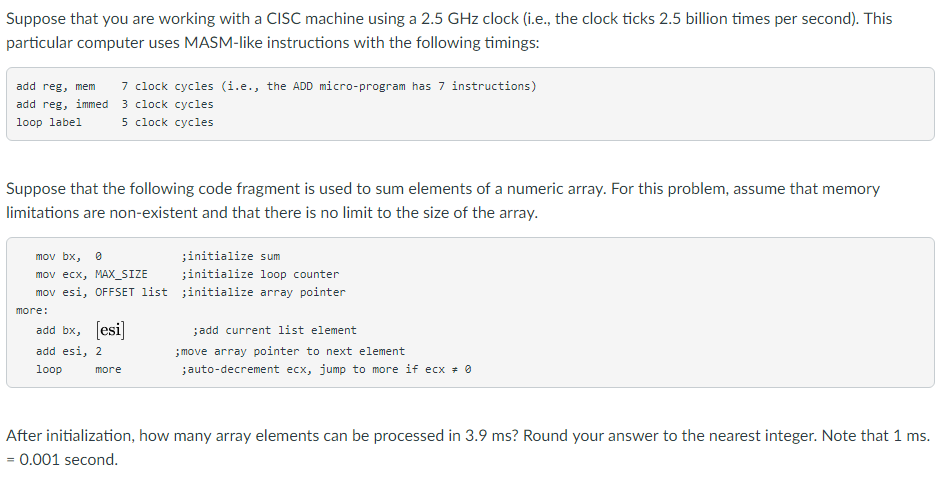Answered step by step
Verified Expert Solution
Question
1 Approved Answer
I believe the answer is 250,000 iterations but would appreciate a second opinion. 2.5 Ghz clock = 2,500,000,000 7+3+5 = 15 cycles In 3.9 m/s

I believe the answer is 250,000 iterations but would appreciate a second opinion.
2.5 Ghz clock = 2,500,000,000
7+3+5 = 15 cycles
In 3.9 m/s a processor can do 2,500,000,000 x 0.0015 =3,750,000 cycles
3,750,000 cycles/15 = 250,000 iterations.
Suppose that you are working with a CISC machine using a 2.5 GHz clock (i.e., the clock ticks 2.5 billion times per second). This particular computer uses MASM-like instructions with the following timings: add reg, mem 7 clock cycles (i.e., the ADD micro-program has 7 instructions) add reg, immed 3 clock cycles loop label 5 clock cycles Suppose that the following code fragment is used to sum elements of a numeric array. For this problem, assume that memory limitations are non-existent and that there is no limit to the size of the array. mov bx, 0 mov ecx, MAX_SIZE mov esi, OFFSET list ;initialize array pointer ;initialize sum ;initialize loop counter more add bx, esi add esi, 2 loop ;add current list element ;move array pointer to next element ;auto-decrement ecx, jump to more If ecx 0 more After initialization, how many array elements can be processed in 3.9 ms? Round your answer to the nearest integer. Note that 1 ms : 0.001 second Suppose that you are working with a CISC machine using a 2.5 GHz clock (i.e., the clock ticks 2.5 billion times per second). This particular computer uses MASM-like instructions with the following timings: add reg, mem 7 clock cycles (i.e., the ADD micro-program has 7 instructions) add reg, immed 3 clock cycles loop label 5 clock cycles Suppose that the following code fragment is used to sum elements of a numeric array. For this problem, assume that memory limitations are non-existent and that there is no limit to the size of the array. mov bx, 0 mov ecx, MAX_SIZE mov esi, OFFSET list ;initialize array pointer ;initialize sum ;initialize loop counter more add bx, esi add esi, 2 loop ;add current list element ;move array pointer to next element ;auto-decrement ecx, jump to more If ecx 0 more After initialization, how many array elements can be processed in 3.9 ms? Round your answer to the nearest integer. Note that 1 ms : 0.001 secondStep by Step Solution
There are 3 Steps involved in it
Step: 1

Get Instant Access to Expert-Tailored Solutions
See step-by-step solutions with expert insights and AI powered tools for academic success
Step: 2

Step: 3

Ace Your Homework with AI
Get the answers you need in no time with our AI-driven, step-by-step assistance
Get Started


